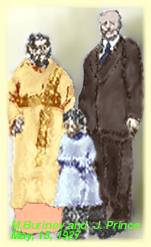| We agreed to accept this invitation and on
May 15, 1927, we drove out to the Kalmyk colony, the members of which
inhabit clean but small wooden houses on the outskirts of Belgrade. There,
after receiving the formal greetings of the members of the colony, we entered
the house to attend the service.
Inasmuch as I am unable to find any detailed description of such a rite in any works on Lamaistic Buddhism, which deal chiefly with the faith of the Tibetan Buddhistic school, I  venture
to give herewith a full account of the ceremonies, which I saw at very
close range, as Colonel Godson and myself stood in close proximity to the
officials in front of the shrine. venture
to give herewith a full account of the ceremonies, which I saw at very
close range, as Colonel Godson and myself stood in close proximity to the
officials in front of the shrine.
The shrine consists of a square box of about three by three feet, covered with light blue paper and set upon an ordinary table also draped in blue. Hang on the wall around the shrine are paintings of various Lamaistic saints, and, standing on top of the shrine-box, is a brass image of the first successor of Gautama Buddha. The front of the shrine is a square opening measuring about two by two feet, and inside a tabernacle placed upon a shelf, halfway up in the middle of the opening, is a very small image of the Buddha in black teak, surmouned by a paper representation of the triple Lamaistic mitre. In front of the shrine stands a credence, upon which are laid in serried rows fifteen small silver cups, in one of which burns small wax candle. The Chief Lama, Assistant Lama, and the Cantor stand side by side, facing the altar with a small table near them, on which are the aspergil, fixed in a small silver urn filled with holy water, a flagon filled with colored sugared water, and a brass dish, together with a dish full of roasted barleycorn. On this serving table is also spread out an orange-colored maniple (armkerchief). The two Celebrants and the Cantor, standing side by side before the shrine, begin to intone, mostly in a unison varying only on two deep noes, certain prescribed aspirations to the Buddha from the Tibetan Lamaistic books in the Tibetan ritual language. I observed with great interest the at the close of each long phrase, the singers expelled their breath with a choking sound. |